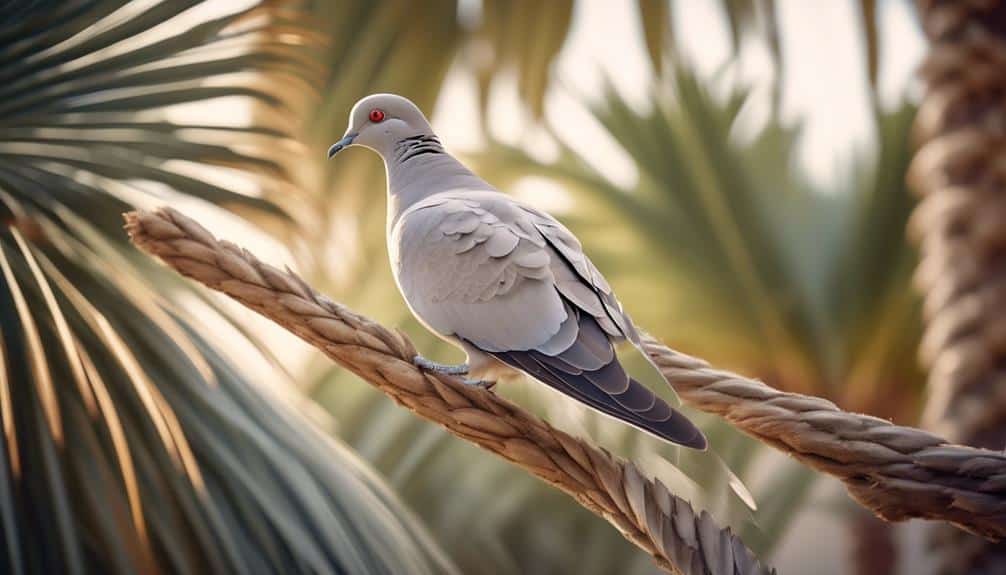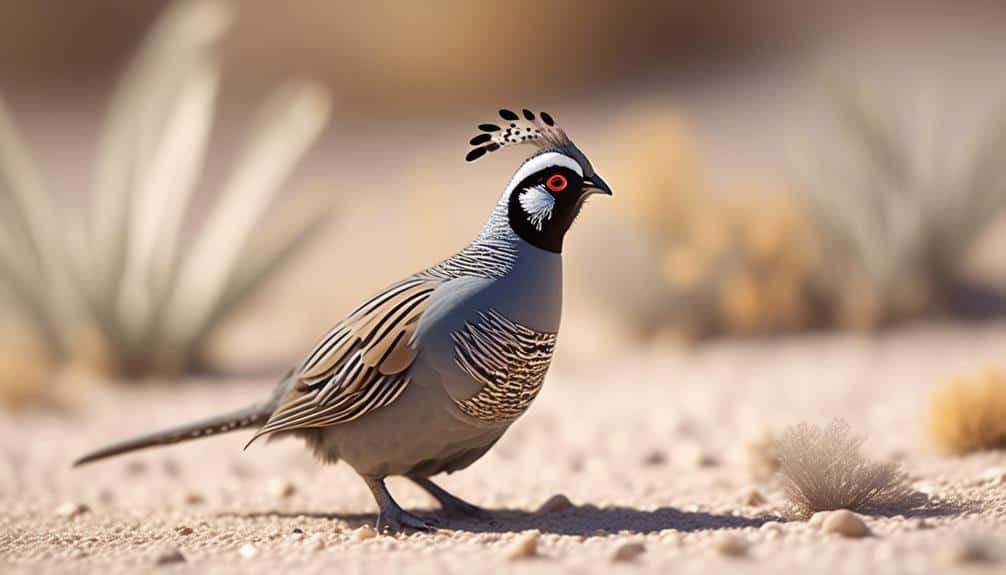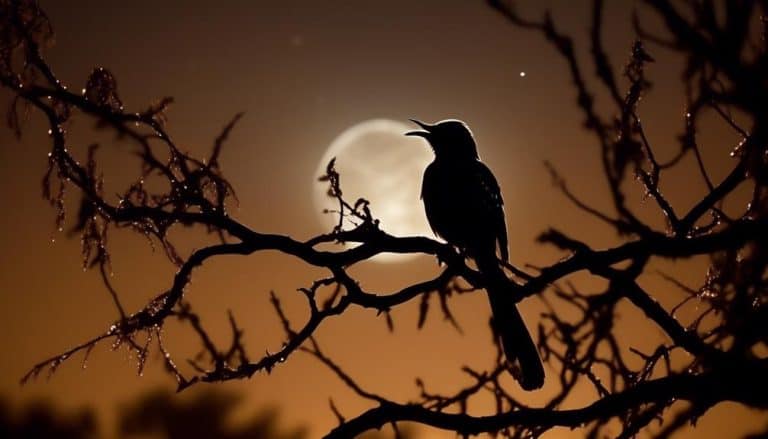As I step out into the warm desert air of Palm Springs, the sky above comes alive with a symphony of fluttering wings and melodic chirps. The avian residents of this vibrant oasis paint the landscape with their colorful feathers and captivating songs, like a living tapestry woven by nature's hand.
But these common birds of Palm Springs are more than just beautiful creatures; they hold tales of resilience, adaptation, and the delicate balance of life in this arid paradise.
So, join me on this journey as we explore the remarkable world of these winged wonders and uncover the hidden secrets they hold within their feathers.
Vibrant Western Bluebird

The Vibrant Western Bluebird, known scientifically as Sialia mexicana, is a stunning bird species found in the Palm Springs area. This magnificent bird is known for its vibrant blue plumage, which makes it a favorite among birdwatchers and nature enthusiasts.
The Western Bluebird is a social bird that's often found in small flocks, especially during the non-breeding season. They're known for their melodious songs and their ability to perform aerial acrobatics during courtship displays.
In terms of behavior, the Western Bluebird is primarily insectivorous, feeding on a variety of insects and spiders. They're also known to consume small fruits and berries, particularly during the winter months when their preferred food sources are scarce. These birds are cavity nesters, meaning they build their nests in pre-existing holes in trees or man-made nest boxes. They're known to be territorial during the breeding season and will defend their nesting sites vigorously.
In terms of habitat, the Western Bluebird prefers open woodlands and forest edges with scattered trees. They're particularly fond of areas with ample perches, such as fence posts or dead trees, from which they can scan the surroundings for potential prey. They're also commonly found in grasslands and meadows with scattered trees or shrubs.
Majestic Great Horned Owl

A magnificent bird of prey found in the Palm Springs area is the majestic Great Horned Owl. With its distinctive ear-like tufts and piercing yellow eyes, this owl commands attention wherever it's spotted.
The behavior and hunting habits of the great horned owl are fascinating and have made it a vital species in the ecological balance of the Palm Springs area. Great Horned Owls are known for their exceptional hunting skills. They're opportunistic predators, preying on a wide range of animals, including rodents, rabbits, birds, and even reptiles.
These owls are silent hunters, thanks to their specialized feathers that muffle the sound of their wings as they fly. They often perch on high tree branches, patiently waiting for their prey to come within striking distance.
The ecological significance of the great horned owl in the Palm Springs area can't be overstated. As top predators, they help control the populations of their prey species, preventing overpopulation and maintaining a healthy balance in the ecosystem.
Additionally, their diet includes many small mammals, which can be harmful to crops and gardens. By controlling these populations, the great horned owl indirectly benefits farmers and gardeners in the area.
Graceful White-winged Dove

With its striking appearance and graceful flight, the white-winged dove seamlessly takes its place among the diverse bird species found in the Palm Springs area. Native to the southwestern United States and Mexico, this species thrives in the arid and semi-arid regions, making it well-adapted to the desert environment of Palm Springs.
The white-winged dove prefers to make its home in mesquite woodlands, desert washes, and urban parks. These areas provide the necessary habitat for nesting and roosting. In Palm Springs, the dove is often seen perched on tree branches or telephone wires, scanning the surroundings for potential food sources.
Speaking of food, the white-winged dove has a varied diet. It primarily feeds on seeds, fruits, and insects. In urban areas, it isn't uncommon to see these doves feeding on bird feeders or scavenging for fallen fruits from the numerous fruit trees in the region. They're also known to visit flowering plants and cacti, where they can find nectar and insects.
Colorful Vermilion Flycatcher

Nestled among the vibrant bird species of Palm Springs, the Colorful Vermilion Flycatcher stands out with its vibrant plumage and unique hunting techniques. This small bird, measuring about 6 inches in length, is known for its striking red plumage on its head, chest, and underparts, while its back and wings are dark brown. The male Vermilion Flycatcher is particularly eye-catching, with its contrasting colors and long, elegant tail.
The Vermilion Flycatcher is a resident bird in Palm Springs, meaning it doesn't migrate to other areas during specific seasons. It can be found year-round, making it a delightful sight for birdwatchers and nature enthusiasts alike.
When it comes to nesting, the Vermilion Flycatcher builds its nest in low shrubs or trees, usually around 5 to 10 feet above the ground. The nest is made of twigs and grasses, lined with feathers and other soft materials. The female flycatcher lays 2 to 4 eggs, which she incubates for about 14 days. Once the eggs hatch, both parents take turns feeding their young until they're ready to fledge.
The Colorful Vermilion Flycatcher is truly a remarkable bird, both in appearance and behavior. Its presence adds a touch of vibrancy to the bird community in Palm Springs, making it a favorite among bird enthusiasts.
Charming Gambel's Quail

The avian diversity in Palm Springs extends beyond the vibrant plumage of the Colorful Vermilion Flycatcher, as the charming Gambel's Quail adds its unique charm to the local bird community. Known for their distinctive topknot plume on their heads, Gambel's Quail are a common sight in the desert regions of the southwestern United States, including Palm Springs.
Gambel's Quail are primarily resident birds, meaning they do not migrate long distances like some other bird species. However, they do exhibit some seasonal movements within their home range in response to changing environmental conditions. During the breeding season, which typically occurs from spring to early summer, Gambel's Quail form monogamous pairs and establish territories. They are known for their unique behavior traits, such as their distinctive "chip-chip-chip" call and their habit of running rather than flying when disturbed.
To provide a comprehensive overview of Gambel's Quail, here is a table that summarizes their key characteristics:
| Trait | Description |
|---|---|
| Scientific Name | Callipepla gambelii |
| Habitat | Arid desert regions, shrublands, and grassy areas |
| Diet | Herbivorous, feeding on seeds, fruits, and vegetation |
Frequently Asked Questions
What Is the Average Lifespan of a Western Bluebird?
The average lifespan of a Western bluebird is around 6 years. These beautiful birds are known for their vibrant blue feathers and can be found in various habitats across North America.
How Far Do Great Horned Owls Migrate During the Winter Months?
During the winter months, great horned owls in Palm Springs can migrate up to several hundred miles in search of food and suitable habitat. Factors such as prey availability and weather conditions influence their migration patterns.
What Is the Preferred Habitat of the White-Winged Dove?
The white-winged dove prefers arid habitats with ample sources of food such as seeds, fruits, and grains. They are known for their unique cooing calls and are common in the Palm Springs area. Their nesting habits and breeding season vary depending on the region.
How Does the Vermilion Flycatcher Attract Its Prey?
The vermilion flycatcher attracts its prey by using various hunting techniques. It relies on its bright red plumage and its ability to perform aerial acrobatics to catch insects mid-air.
Are Gambel's Quails Commonly Found in Urban Areas of Palm Springs?
Yes, Gambel's quails are commonly found in urban areas of Palm Springs, providing excellent birdwatching opportunities. These birds prefer shrubby habitats and can often be seen foraging for seeds and insects.
Conclusion
As I conclude my exploration of the common birds in Palm Springs, I'm filled with awe and wonder at the vibrant tapestry of nature's artistry. Like a symphony of colors and melodies, the Western Bluebird, Great Horned Owl, White-winged Dove, Vermilion Flycatcher, and Gambel's Quail grace this desert oasis with their presence.
Each one a testament to the intricate beauty of our natural world. Let's cherish and protect these exquisite creatures, for they're a precious gift that enriches our lives.







